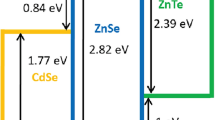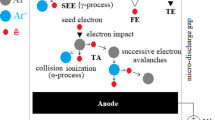Abstract
A numerical model of the negative DC corona plasma along a thin wire in dry air is presented. The electron number density and electric field are determined from solution of the one-dimensional coupled continuity equations of charge carriers and Maxwell's equation. The electron kinetic energy distribution is determined from the spatially homogeneous Boltzmann equation. A parametric study is conducted to examine the effects of linear current density (0.1–100 μA per cm of wire length), wire radius (10–1000 μm), and air temperature (293–800 K) on the distribution of electrons and the Townsend second ionization coefficient. The results are compared to those previously determined for the positive corona discharge. In the negative corona, energetic electrons are present beyond the ionization boundary and the number of electrons is an order of magnitude greater than in the positive corona. The number of electrons increases with increasing gas temperature. The electron energy distribution does not depend on discharge polarity.
Similar content being viewed by others
REFERENCES
F. G. Cottrell, U.S. Patent, 895,729 (1908).
F. G. Cottrell, J. Ind. and Eng. Chem. 3, 542(1911).
H. J. White, Industrial Electrostatic Precipitation, Addison-Wesley Publishing Company, Inc., 1963.
A. D. Moore, Electrostatics and Its Applications, John Wiley & Sons, New York, 1973.
J. A. Cross, Electrostatics: Principles, Problems and Applications, Adam Hilger, Bristol, England, 1987.
A. P. Napartovich, Proceedings of the International Symposium on High Pressure Low Temperature Plasma Chemistry, Vol. 1 (H. Wagner, J. F. Behnke, and G. Babucke, eds.), Greifswald, Germany, pp. 122–128 (2000).
Y. Akishev, S. Kroepke, J. Behnisch, A. Hollander, A. Napartovich, and N. Trushkin, Proceedings of the International Symposium on High Pressure Low Temperature Plasma Chemistry, Vol. 2 (H. Wagner, J. F. Behnke, and G. Babucke, eds.), Greifswald, Germany, pp. 481–485 (2000).
M. L. Balmer, G. Fisher, and J. Hoard, Non-Thermal Plasma for Exhaust Emission Control: NO x , HC, and Particulates, Society of Automotive Engineers, Inc., Warrendale, PA, 1999.
T. Hammer, Contributions to Plasma Phys. 39, 441–462 (1999).
T. Hammer, Proceedings of the International Symposium on High Pressure Low Temperature Plasma Chemistry, Vol. 2 (H. Wagner, J. F. Behnke, and G. Babucke, eds.), Greifswald, Germany, pp. 234–241 (2000).
W. Manheimer, L. E. Sugiyama, and T. H. Stix, Plasma Science and the Environment, American Institute of Physics Press, Woodbury, New York, 1997.
B. M. Penetrante and S. E. Schultheis, Non-Thermal Plasma Techniques for Pollution Control Part A: Overview, Fundamentals and Supporting Technologies, Springer-Verlag, Berlin, 1993.
B. M. Penetrante and S. E. Schultheis, Non-Thermal Plasma Techniques for Pollution Control Part B: Electron Beam and Electrical Discharge Processing, Springer-Verlag, Berlin, 1993.
B. M. Penetrante, J. N. Bardsley, and M. C. Hsiao, Jpn. J. Appl. Phys. 36, 5007–5017 (1997).
R. G. Rice and A. Netzer, Handbook of Ozone Technology and Applications, Ann Arbor, Mich., 1982.
B. Eliasson, M. Hirth, and U. Kogelschatz, J. Phys. D: Appl. Phys. 20, 1421–1437 (1987).
K. Boelter and J. H. Davidson, Aerosol Sci. and Technol. 27, 690–708 (1997).
A. S. Viner, P. A. Lawless, D. S. Ensor, and L. E. Sparks, IEEE Trans. Ind. Appl. 28, 504–512 (1992).
M. B. Awad and G. S. P. Castle, J. Air Pollu. Con. Assoc. 25, 369–374 (1975).
T. Ohkubo, S. Hamasaki, Y. Nomoto, J. S. Chang, and T. Adachi, IEEE Trans. Ind. Appl. 26, 542–549 (1990).
K. Nashimoto, J. Imaging Sci. 32, 205–210 (1988).
P. Cooperman, Trans. Amer. Inst. Elec. Eng. Part 1 79, 47–50 (1960).
G. Cooperman, IEEE Transactions on Industry Applications 1A-17, 236–239 (1981).
G. Leutert and B. Bohlen, Staub-Reinhalt. Luft 32, 27–37 (1972) (in English).
J. R. McDonald, W. B. Smith, H. W. Spencer III, and L. E. Sparks, J. Appl. Phys. 48, 2231–2243 (1977).
M. P. Sarma and W. Janischewskyj, Proc. IEE 116, 161–166 (1969).
E. U. Landers, Proc. IEE 125, 1069–1073 (1978).
J. Chen and J. H. Davidson, Plasma Chem. Plasma Process. 22, 199–224 (2002).
J. D. Cobine, Gaseous Conductors: Theory and Engineering Applications, Dover Publications, Inc., New York, 1958.
L. B. Loeb, Fundamental Processes of Electrical Discharge in Gases, John Wiley & Sons, Inc., New York, 1947.
L. B. Loeb, Electrical Coronas: Their Basic Physical Mechanisms, Berkeley, University of California Press, 1965.
R. Moprrow, Phys. Rev. A 32, 1799–1809 (1985).
G. N. Aleksandrov, Soviet Phys. Tech. Phys. 1714–1726 (1956).
F. W. Peek, Dielectric Phenomena in High-Voltage Engineering, 3rd ed., McGraw-Hill, New York, 1929.
P. A. Lawless, K. J. McLean, L. E. Sparks, and G. H. Ramsey, J. Electrostatics 18, 199–217 (1986).
Y. Akishev, O. Goossens, T. Callebaut, C. Leys, A. Napartovich, and N. Trushkin, J. Phys. D: Appl. Phys. 34, 2875–2882 (2001).
G. W. Trichel, Phys. Rev. 54, 1078–1084 (1938).
K. J. McLean, P. A. Lawless, L. E. Sparks, and G. H. Ramsey, J. Electrostatics 18, 219–231 (1986).
J. H. Davidson and E. J. Shaughnessy, Experiments in Fluids 4, 17–26 (1986).
Y. P. Raizer, Gas Discharge Physics, Springer, New York, 1997.
E. U. Condon and H. Odishaw, Handbook of Physics, McGraw-Hill, New York, 1967.
C. Kentry, Phys. Rev. 44, 891–897 (1933).
K. Boelter, M.S. Thesis, University of Minnesota-Minneapolis (1996).
J. B. Thomas and E. Wong, J. Appl. Phys. 29, 1226–1230 (1958).
I. A. Kossyi, A. Y. Kotinsky, A. A. Matveyev, and V. P. Silakkov, Plasma Sources Sci. Technol. 1, 207–220 (1992).
J. J. Lowke and R. Morrow, Pure Appl. Chem. 66, 1287–1294 (1994).
M. A. Harrison and R. Geballe, Phys. Rev. 91, 1–7 (1953).
H. Ryzko, Proc. Phys. Soc. 85, 1283–1295 (1965).
L. G. H. Huxley and R. W. Crompton, The Diffusion and Drift of Electrons in Gases, John Wiley & Sons, New York, 1974.
E. W. McDaniel and E. A. Mason, The Mobility and Diffusion of Ions in Gases, John Wiley & Sons, New York, 1973.
R. Morrow, J. Phys. D: Appl. Phys. 30, 3099–3114 (1997).
R. W. Evans and I. I. Inculet, IEEE Trans. Ind. Appl. IA-14, 523–525 (1978).
J. Chen and J. H. Davidson, Plasma Chem. Plasma Process. 22, 499–522 (2002).
Author information
Authors and Affiliations
Rights and permissions
About this article
Cite this article
Chen, J., Davidson, J.H. Model of the Negative DC Corona Plasma: Comparison to the Positive DC Corona Plasma. Plasma Chemistry and Plasma Processing 23, 83–102 (2003). https://doi.org/10.1023/A:1022468803203
Issue Date:
DOI: https://doi.org/10.1023/A:1022468803203




